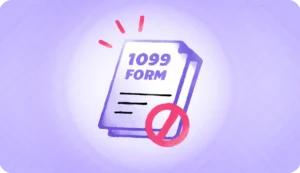The 1099 form is an IRS tax form used to report income received by a person or business that is not an employee. This includes income from freelance work, rent, dividends, and more. Recipients of 1099 forms must report the income on their tax returns.
A marketplace industry often involves transactions between buyers and sellers, and in some cases, the marketplace itself may act as a facilitator or middleman in these transactions. In such a scenario, the marketplace may be required to file 1099 forms if they have paid $600 or more in a tax year to a seller for services rendered.
For example, consider an online marketplace that connects buyers with freelance photographers. If a photographer has earned $700 from the marketplace through sales of their photos, the marketplace would be required to issue a 1099-MISC form to the photographer and file a copy with the IRS by the end of February of the following year. The photographer would then be required to report the income listed on the 1099 form on their tax return. If the photographer is a sole proprietor, they would report the income on Schedule C (Profit or Loss from Business) and if they are an independent contractor, they would report the income on Schedule SE (Self-Employment Tax).
How did 1099 come into existence?
The 1099 form has been around since the inception of the US income tax system. As part of the Internal Revenue Service’s effort to simplify filing, a contemporary version was introduced in the late 1960s. Its purpose is to declare sources of non-salary money, such as dividends, interest payments, capital gains, and rental income.
Throughout the years, the 1099 form has been tweaked to keep up with fluctuations in tax regulations and to guarantee precision and swiftness when it comes to filing taxes. It is now a pivotal component of the American tax process, allowing the IRS to monitor income derived from non-employment sources. In the past few years, they have taken a closer look at 1099 forms as part of their initiatives to stop and forestall tax deception and guarantee that taxpayers are being honest about their earnings.
Importance of 1099
The 1099 form is an important tax document in the United States that serves several important purposes. Here are some of the reasons why the 1099 form is important:
- Reporting income: Individuals who are not employees of a company, such as independent contractors and freelancers, must report income they receive using the 1099 form. The IRS relies on these 1099 forms to ensure that these individuals report and pay taxes on this income, which is important because this income is typically not subject to withholding taxes.
- Compliance: Companies that are required to file 1099 forms must do so in order to comply with federal tax rules. Failure to file these papers, or filing them erroneously, may result in IRS penalties and fines.
- Record Keeping: An individual’s 1099 form provides a record of income received, which is important for tax purposes. It includes the payer’s name and tax identification number, as well as the recipient’s name and address.
- Verification: 1099 forms are used by the IRS to confirm that individuals are accurately reporting their income on their tax returns. An audit or investigation can result if an individual does not report their income accurately.
Type of companies need to file 1099
In the United States, companies are required to file 1099 forms with the Internal Revenue Service (IRS) for certain types of payments made to vendors or independent contractors. Businesses that pay a non-employee vendor or independent contractor $600 or more in the course of their trade or business are required to file a 1099 form.
Companies that have made payments for the following include those that need to file 1099 forms:
- Services performed by independent contractors, such as consultants or freelancers
- Rent paid for office space or other facilities
- Interest or dividends paid on investments
- Royalties paid for the use of intellectual property, such as patents or copyrights
- Other income payments, such as prizes or awards
Determining if a worker is an employee or an independent contractor for 1099 purposes
The IRS provides a set of criteria to determine whether a worker is an employee or an independent contractor for tax purposes. These criteria revolve around the level of control the business has over the worker and the work being performed.
Here are some key factors to consider when making this determination:
- Behavioral control: Does the business control how the work is performed, including the methods used to complete the work and the type of training provided to the worker?
- Financial control: Does the worker have a significant investment in the tools, equipment, or facilities used to perform the work? Does the worker have the opportunity to make a profit or loss from the work performed?
- Relationship of the parties: Is there a written contract between the business and the worker? Does the worker receive benefits or have a long-term working relationship with the business?
Overall, if the business has a high degree of control over the worker and the work being performed, the worker is likely to be classified as an employee. If the worker has a greater degree of independence and control over the work, they may be classified as an independent contractor.
It’s important to note that misclassifying workers as independent contractors when they should be classified as employees can have serious legal and financial consequences. If unsure about how to classify a worker, it’s a good idea to seek guidance from a tax professional or an employment lawyer.

Types of 1099 form fillings crucial for companies
The different 1099 forms are used to report various types of income or payments made to individuals or businesses. Here’s a brief overview of when each form is typically used:
- 1099-C: This form is used to report the canceled debt of $600 or more. This might include things like credit card debt or forgiven loans.
- 1099-DIV: This form is used to report dividends and other distributions of $10 or more that have been paid out to shareholders of stocks, mutual funds, and other investments.
- 1099-R: This form is used to report distributions of $10 or more from retirement plans like pensions, IRAs, and 401(k)s.
- 1099-G: This form is used to report government payments of $10 or more, such as unemployment benefits, state tax refunds, or agricultural payments.
- Form 1099-NEC: This form is used to report non-employee compensation of $600 or more, such as payments made to independent contractors, freelancers, or consultants.
- Form 1099-MISC: This form is used to report miscellaneous income of $600 or more that doesn’t fit into any other category, such as rent payments or royalties.
- Form 1099-K: This form is used to report payments made through third-party payment processors like PayPal, Stripe, or Square. This form is used for payments totalling $20,000 or more and 200 or more transactions.
- Form 1099-INT: This form is used to report interest income of $10 or more paid to individuals or businesses, such as from bank accounts or bonds.
Negative implications on companies that do not follow the 1099 form filing
- Financial penalties: The IRS imposes penalties for failing to file 1099 forms on time, or filing incorrect or incomplete forms.
- Legal action: Companies may be subject to legal action by contractors or freelancers who were not properly reported to the IRS, or who did not receive the necessary forms to properly file their taxes.
- Reputation damage: Failing to follow 1099 filing requirements can harm a company’s reputation and credibility, potentially affecting its ability to do business with other contractors and partners.
- Internal problems: Companies that fail to properly file 1099s may experience internal problems, such as difficulty tracking expenses, miscommunication between departments, and increased administrative burdens.
UBER paying $22M as penalities – Case study
Uber is a popular ride-sharing company that operates in many cities around the world. As part of its business model, Uber relies on independent contractors (drivers) to provide transportation services to customers.
In 2017, Uber faced scrutiny from the Federal Trade Commission (FTC) over its failure to file 1099 forms for its drivers. Under federal law, businesses are required to issue 1099 forms to independent contractors who earn more than $600 in a year. By failing to do so, Uber may have avoided paying some of its fair share of taxes.
The issue of 1099 filing was closely tied to Uber’s classification of its drivers as independent contractors, rather than employees. Because Uber did not treat its drivers as employees, the company did not provide them with the same benefits and protections, including health insurance, workers’ compensation, and overtime pay. This classification also meant that Uber was not required to file certain tax forms, including W-2 forms, that are typically issued to employees.
In order to resolve the issue with the FTC, Uber agreed to pay $22 million as penalties and change some of its business practices. The company agreed to implement a new system for tracking and reporting driver earnings, which would help ensure that drivers are properly classified as independent contractors and receive the appropriate tax forms.
This case illustrates the importance of 1099 filing for businesses that rely on independent contractors. Even if a business does not classify its workers as employees, it may still be required to file 1099 forms if the workers earn more than a certain amount. Failing to file these forms can result in significant legal and financial consequences, as Uber learned through its settlement with the FTC.
The process of filing 1099
- Determining if the form is required: A 1099 form is required to be filed if a person or business has paid an individual or unincorporated business $600 or more in a tax year for services rendered.
- Gathering information: The payer must gather the recipient’s name, address, and taxpayer identification number (TIN) for the form.
- Issuing the form: The payer must issue a 1099 form to the recipient by January 31st of the year following the payment.
- Filing with the IRS: The payer must also file a copy of the 1099 form with the IRS by February 28th (or March 31st if filing electronically).
- Reporting the income: The recipient must report the income listed on the 1099 form on their tax return.
Information required for the 1099 form
The 1099 form requires information about payments made to an individual or unincorporated business for services rendered, rent, or other income received. The information required includes:
- Payee’s legal name
- Payee’s taxpayer identification number (TIN), either Social Security Number (SSN) or Employer Identification Number (EIN)
- Total amount of payments made during the year
- Type of payments (e.g. non-employee compensation, rent, interest, dividends, etc.)
- This information can be obtained from the recipient of the payments, invoices, or other financial records.
Correcting errors on a previously filed 1099 form
Errors on a previously filed 1099 form can be corrected by using a corrected 1099 form. Companies should follow these steps to correct errors on a 1099 form:
- Obtain a corrected 1099 form from the tax form provider or from the IRS website.
- Fill out the corrected form with the correct information and mark it as a correction form.
- File the corrected form with the IRS and provide a copy to the recipient.
- Keep a copy of the corrected form for the company’s records.
It’s important for companies to correct errors on 1099 forms as soon as they are discovered to ensure compliance with tax laws and regulations and avoid potential penalties. If a company discovers errors after the filing deadline has passed, they should still file corrected forms as soon as possible to minimize potential penalties.
Ensuring the company’s 1099 form filings comply with tax laws and regulations
To guarantee your 1099 form filings follow tax laws and regulations, it is important to adhere to the following best practices:
- Properly classify workers as employees or independent contractors, using the criteria set by the IRS.
- Maintain complete and accurate records of payments made to independent contractors.
- File 1099 forms and provide copies to recipients by the deadline, whether filed electronically or on paper.
- Use accurate and complete information on the 1099 forms, including the recipient’s name, address, and taxpayer identification number (TIN).
- Verify the accuracy of the information on the 1099 forms before filing.
- Correct any errors on 1099 forms as soon as they are discovered, using corrected forms if necessary.
- Keep copies of all 1099 forms and related documentation for at least three years.
You can find more information on how to identify a fake 1099 form here.
FAQs
Who is responsible for filling 1099 form?
Form 1099 is typically filled out and filed by businesses or individuals who have paid at least $600 to a non-employee service provider or contractor during the tax year.
When is 1099 filled?
Form 1099 must be filled out and sent to the IRS by January 31 of the year following the tax year in which the payments were made.
What are the penalties for failing to file Form 1099?
The penalties for failing to file Form 1099 can vary depending on the severity of the violation and how late the form is filed. Penalties can range from $50 per form for a timely filing with correct information, up to $550 per form for intentionally disregarding the filing requirement.





















